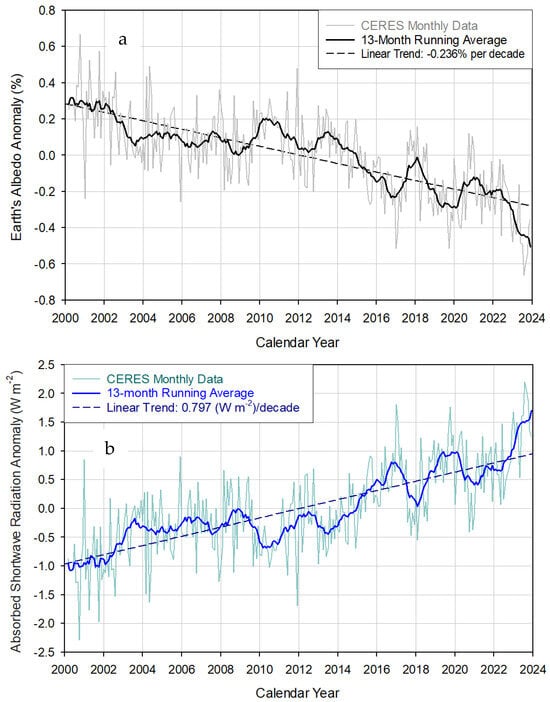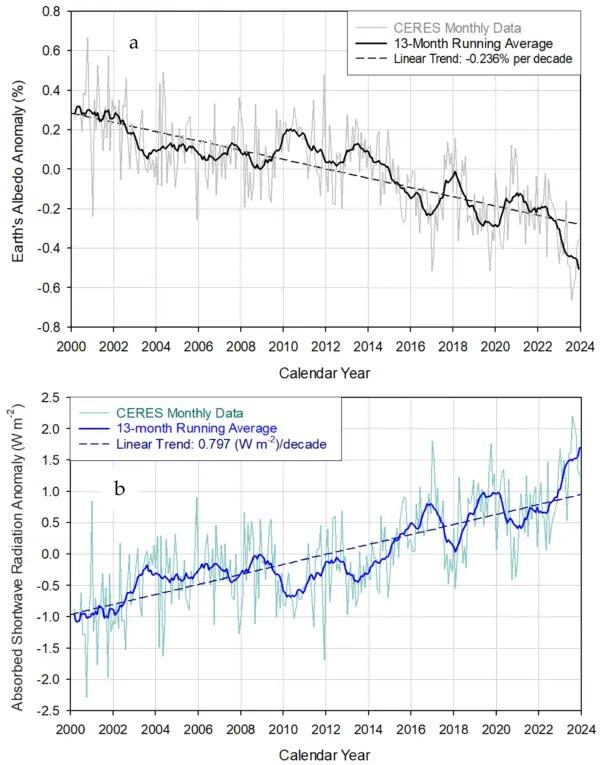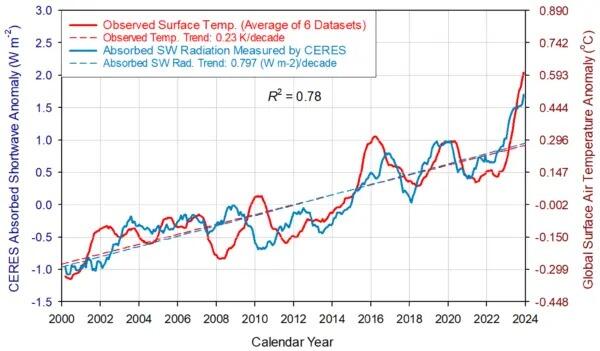Кој се збогатувал во ЕУ од лагата за “глобално затоплување’’
- Креатор на темата Misirkov
- Време на започнување
Vanlok
deus ex machina
- Член од
- 30 мај 2009
- Мислења
- 26.202
- Поени од реакции
- 34.788

Personal carbon footprint of the rich is vastly underestimated by rich and poor alike, study finds
The personal carbon footprint of the richest people in society is grossly underestimated, both by the rich themselves and by those on middle and lower incomes,
Vanlok
deus ex machina
- Член од
- 30 мај 2009
- Мислења
- 26.202
- Поени од реакции
- 34.788
@Human нели зборував за облаците/албедото како значаен фактор кој во извесна мера се игнорира?
Тогаш се смееше, а сега?

 www.mdpi.com
www.mdpi.com
Submission received: 2 July 2024 / Revised: 6 August 2024 / Accepted: 17 August 2024 / Published: 20 August 2024
Abstract
Past studies have reported a decreasing planetary albedo and an increasing absorption of solar radiation by Earth since the early 1980s, and especially since 2000. This should have contributed to the observed surface warming. However, the magnitude of such solar contribution is presently unknown, and the question of whether or not an enhanced uptake of shortwave energy by the planet represents positive feedback to an initial warming induced by rising greenhouse-gas concentrations has not conclusively been answered. The IPCC 6th Assessment Report also did not properly assess this issue. Here, we quantify the effect of the observed albedo decrease on Earth’s Global Surface Air Temperature (GSAT) since 2000 using measurements by the Clouds and the Earth’s Radiant Energy System (CERES) project and a novel climate-sensitivity model derived from independent NASA planetary data by employing objective rules of calculus. Our analysis revealed that the observed decrease of planetary albedo along with reported variations of the Total Solar Irradiance (TSI) explain 100% of the global warming trend and 83% of the GSAT interannual variability as documented by six satellite- and ground-based monitoring systems over the past 24 years. Changes in Earth’s cloud albedo emerged as the dominant driver of GSAT, while TSI only played a marginal role. The new climate sensitivity model also helped us analyze the physical nature of the Earth’s Energy Imbalance (EEI) calculated as a difference between absorbed shortwave and outgoing longwave radiation at the top of the atmosphere. Observations and model calculations revealed that EEI results from a quasi-adiabatic attenuation of surface energy fluxes traveling through a field of decreasing air pressure with altitude. In other words, the adiabatic dissipation of thermal kinetic energy in ascending air parcels gives rise to an apparent EEI, which does not represent “heat trapping” by increasing atmospheric greenhouse gases as currently assumed. We provide numerical evidence that the observed EEI has been misinterpreted as a source of energy gain by the Earth system on multidecadal time scales.
По „народски“ објаснето:

 www.theepochtimes.com
www.theepochtimes.com
Through analyzing the Earth’s Energy Imbalance (EEI), “calculated as a difference between absorbed shortwave and outgoing longwave radiation at the top of the atmosphere,” Nikolov and Zeller discovered that the scientific community had misinterpreted it.
“EEI is not caused by ‘heat-trapping’ resulting from increasing atmospheric greenhouse gasses as currently claimed, but ‘arises from adiabatic dissipation of thermal energy in ascending air parcels in the troposphere due to a decreasing atmospheric pressure with height,’” Nikolov said.
Specifically, using mathematics, Nikolov and Zeller showed that EEI is an “apparent phenomenon” rather than a “real imbalance,” which they said necessarily implies no long-term heat storage in the Earth system by increasing greenhouse gases and no “warming in the pipeline,” as claimed by the latest Report by the IPCC.
Where Are the Clouds?
Nikolov said Earth’s reduced cloud cover could have several causes, including galactic cosmic rays, solar wind, and interactions between the Sun’s and Earth’s magnetic fields.
If rising global temperature was due to greenhouse gasses, there should have been more warming than observed, he said.
Тогаш се смееше, а сега?

Roles of Earth’s Albedo Variations and Top-of-the-Atmosphere Energy Imbalance in Recent Warming: New Insights from Satellite and Surface Observations
Past studies have reported a decreasing planetary albedo and an increasing absorption of solar radiation by Earth since the early 1980s, and especially since 2000. This should have contributed to the observed surface warming. However, the magnitude of such solar contribution is presently...
Submission received: 2 July 2024 / Revised: 6 August 2024 / Accepted: 17 August 2024 / Published: 20 August 2024
Abstract
Past studies have reported a decreasing planetary albedo and an increasing absorption of solar radiation by Earth since the early 1980s, and especially since 2000. This should have contributed to the observed surface warming. However, the magnitude of such solar contribution is presently unknown, and the question of whether or not an enhanced uptake of shortwave energy by the planet represents positive feedback to an initial warming induced by rising greenhouse-gas concentrations has not conclusively been answered. The IPCC 6th Assessment Report also did not properly assess this issue. Here, we quantify the effect of the observed albedo decrease on Earth’s Global Surface Air Temperature (GSAT) since 2000 using measurements by the Clouds and the Earth’s Radiant Energy System (CERES) project and a novel climate-sensitivity model derived from independent NASA planetary data by employing objective rules of calculus. Our analysis revealed that the observed decrease of planetary albedo along with reported variations of the Total Solar Irradiance (TSI) explain 100% of the global warming trend and 83% of the GSAT interannual variability as documented by six satellite- and ground-based monitoring systems over the past 24 years. Changes in Earth’s cloud albedo emerged as the dominant driver of GSAT, while TSI only played a marginal role. The new climate sensitivity model also helped us analyze the physical nature of the Earth’s Energy Imbalance (EEI) calculated as a difference between absorbed shortwave and outgoing longwave radiation at the top of the atmosphere. Observations and model calculations revealed that EEI results from a quasi-adiabatic attenuation of surface energy fluxes traveling through a field of decreasing air pressure with altitude. In other words, the adiabatic dissipation of thermal kinetic energy in ascending air parcels gives rise to an apparent EEI, which does not represent “heat trapping” by increasing atmospheric greenhouse gases as currently assumed. We provide numerical evidence that the observed EEI has been misinterpreted as a source of energy gain by the Earth system on multidecadal time scales.
Автоматски споено мислење:
По „народски“ објаснето:

Sunlight and Clouds, Not CO2, Drive Earth’s Climate, New Study Finds
The two researchers concluded that the Earth has warmed because it’s absorbing more sunlight because of reduced global cloud cover.
Through analyzing the Earth’s Energy Imbalance (EEI), “calculated as a difference between absorbed shortwave and outgoing longwave radiation at the top of the atmosphere,” Nikolov and Zeller discovered that the scientific community had misinterpreted it.
“EEI is not caused by ‘heat-trapping’ resulting from increasing atmospheric greenhouse gasses as currently claimed, but ‘arises from adiabatic dissipation of thermal energy in ascending air parcels in the troposphere due to a decreasing atmospheric pressure with height,’” Nikolov said.
Specifically, using mathematics, Nikolov and Zeller showed that EEI is an “apparent phenomenon” rather than a “real imbalance,” which they said necessarily implies no long-term heat storage in the Earth system by increasing greenhouse gases and no “warming in the pipeline,” as claimed by the latest Report by the IPCC.
Where Are the Clouds?
Nikolov said Earth’s reduced cloud cover could have several causes, including galactic cosmic rays, solar wind, and interactions between the Sun’s and Earth’s magnetic fields.
He called for “large-scale interdisciplinary research into the physical mechanisms controlling the Earth’s albedo and cloud physics,” as they are “the real drivers of climate on multi-decadal time scales.”“We have hypotheses about what’s driving the cloud cover changes, but we don’t have an exact mechanism or a conclusive theory,” Nikolov said.
“This is why we cannot mathematically describe it yet in a model to make predictions. ”
“The current climate science acknowledges that the clouds have been declining, and the Earth’s albedo has been decreasing, but they attribute it to an internal climate variability. This is incorrect! Changes of cloud cover and albedo are externally forced. Identifying this external forcing is where future research has to focus instead of studying carbon emissions and [greenhouse gas] radiative forcing,” Nikolov said.
If rising global temperature was due to greenhouse gasses, there should have been more warming than observed, he said.
“The simple fact is that the solar forcing alone explains the entire warming of the 21st century and leaves no room for any anthropogenic forcing.
“This inconvenient truth for the UN’s Climate Agenda might explain the absence of discussion in the 2021 IPCC Sixth Assessment Report about the decrease of Earth’s albedo since 2000 observed by [NASA’s Clouds and the Earth’s Radiant Energy System] and its impact on recent warming.”
Human
Explorer
- Член од
- 10 октомври 2009
- Мислења
- 12.435
- Поени од реакции
- 5.128
@Human нели зборував за облаците/албедото како значаен фактор кој во извесна мера се игнорира?
Тогаш се смееше, а сега?
Понатаму,The IPCC AR6 Working Group I (WG1) concluded that well-mixed greenhouse gases were “very likely the main driver of tropospheric warming since 1979”
Оттука произлегува и фактот што количината на водена пареа и до некој степен метанот се директна последица на нивото на СО2 во атмосферата.
А зошто се намалува албедото (рефлективноста) на Земјата е прашање што не мора да си го поставиме, така?This reduction in albedo can be attributed partly to the long-term increase in Earth's average surface temperatures, known as global warming. Caused mainly by human-induced emissions of greenhouse gases, global warming reduces albedo, which in turn leads to further warming. This creates a feedback loop, a vicious cycle accelerating the rate of climate change.

Vanlok
deus ex machina
- Член од
- 30 мај 2009
- Мислења
- 26.202
- Поени од реакции
- 34.788
Тоа не е факт. Факт е докажана теза, вистината. Не дека нема поврзаност, туку дека СО2 не е најголемиот фактор кој влијае.Оттука произлегува и фактот што количината на водена пареа и до некој степен метанот се директна последица на нивото на СО2 во атмосферата.
Тезата на научната студија, која не ја коментираш, е директно спротивна на твојава теза. Кои се твоите аргументи?
Противењето не е аргумент, мора да го знаеш тоа (ако не друго).
Ако го имаш одговорот, пиши им одма на авторите на студијата погоре. Баш тоа го бараат и ни они ни другите неучници не се сигурни, засега најсилните хипотези се дека влијанието е екстерно... Ваљда ја прочита студијата и/или текстот од медиумот.А зошто се намалува албедото (рефлективноста) на Земјата е прашање што не мора да си го поставиме, така?
Автоматски споено мислење:
Human
Explorer
- Член од
- 10 октомври 2009
- Мислења
- 12.435
- Поени од реакции
- 5.128
Ти читаш, ама не знаеш што читаш.Ако го имаш одговорот, пиши им одма на авторите на студијата погоре. Баш тоа го бараат и ни они ни другите неучници не се сигурни, засега најсилните хипотези се дека влијанието е екстерно... Ваљда ја прочита студијата и/или текстот од медиумот.
Во студијата се расправа за тоа како е поделено и како се зголемува количеството на топлина во атмосферата, и пробува да прикажи дека можеби трансферот на топлина низ атмосферата е малку поразличен од тоа што е општо прифатено.
Впрочем кажува дека емисиите на стакленички гасови претежно СО2 се главната причина за зголемувањето на температурите.
Vanlok
deus ex machina
- Член од
- 30 мај 2009
- Мислења
- 26.202
- Поени од реакции
- 34.788
Не топлината туку притисокот. Топлината е помала како што се оди повисоко - заради притисокот.
Кажи ми после пак кој не чита (или не разбира). И СО2 не е спомнат во ниеден таков контекст освен заедно со другите стакленички гасови како помалку релевантен фактор од албедото/облаците. Убаво нагласуваат дека следно е разјаснување на механизмите кои влијаат на создавањето облаци, и дека причинителите најверојатно се екстерни.
Aj да ти помогнам, тебе и на било кој што го интересира ова.
Ова е ставот на IPCC.
United Nations Intergovernmental Panel on Climate Change (IPCC) states is primarily caused by human-induced increases in carbon dioxide (CO2), a greenhouse gas. ...
In its Sixth Assessment Report, the IPCC states that, due to increased atmospheric CO2 concentration from human greenhouse gas emissions, Earth’s energy budget is out of balance—more thermal energy is being trapped, resulting in elevated temperatures and warmer oceans.
Во контраст, ова долу го велат авторите на студијата што ја покажав пар постови погоре.
“The greenhouse theory claims that atmospheric composition is important,” Nikolov said.
“They are arguing that tiny increases of the carbon dioxide in the atmosphere cause global warming and that we must stop burning fossil fuel to avoid dangerous climate change.
“That is completely wrong.”

Figure 1. Monthly radiative anomalies derived from the CERES EBAF 4.2 dataset: (a) Earth’s global albedo calculated via dividing the reflected all-sky shortwave anomaly by the globally averaged incident solar flux at the TOA (i.e., the global insolation) and multiplying the resulting fraction by 100 to convert to a percent; (b) Earth’s absorbed solar flux calculated via multiplying the CERES reflected all-sky shortwave anomaly by −1 based on the fact that radiation absorption is opposite (and complimentary) to reflection. Courtesy of Ned Nikolov

Figure 7. Comparison between observed GSAT anomalies and CERES-reported changes in the Earth’s absorbed solar flux. The two data series, representing 13-month running means, are highly correlated with the absorbed SW flux, explaining 78% of the GSAT variation (R2 = 0.78). Also, GSAT lags the absorbed shortwave radiation between 0 and 9 months, which indicates that GSAT is controlled by changes in sunlight absorption. Courtesy of Ned Nikolov
Nikolov said that, in the greenhouse theory, atmospheric composition is “very important” for a planet’s global surface temperature.
By applying dimensional analysis to NASA’s data describing the environments of different planets and moons in the solar system—including Earth—Nikolov and Zeller discovered a new universal relationship across planetary bodies. This revealed that the atmosphere warms the surface not through longwave radiation emitted by greenhouse gases but through total pressure—adiabatically, without the loss or gain of heat—and that atmospheric composition has no effect on global temperature.
“EEI is not caused by ‘heat-trapping’ resulting from increasing atmospheric greenhouse gasses as currently claimed, but ‘arises from adiabatic dissipation of thermal energy in ascending air parcels in the troposphere due to a decreasing atmospheric pressure with height,’” Nikolov said.
Specifically, using mathematics, Nikolov and Zeller showed that EEI is an “apparent phenomenon” rather than a “real imbalance,” which they said necessarily implies no long-term heat storage in the Earth system by increasing greenhouse gases and no “warming in the pipeline,” as claimed by the latest Report by the IPCC.
Прочитај ја колумната барем, не биди таков инает да игнорираш студии за сметка на его.

 www.theepochtimes.com
www.theepochtimes.com
Кажи ми после пак кој не чита (или не разбира). И СО2 не е спомнат во ниеден таков контекст освен заедно со другите стакленички гасови како помалку релевантен фактор од албедото/облаците. Убаво нагласуваат дека следно е разјаснување на механизмите кои влијаат на создавањето облаци, и дека причинителите најверојатно се екстерни.
Aj да ти помогнам, тебе и на било кој што го интересира ова.
Ова е ставот на IPCC.
United Nations Intergovernmental Panel on Climate Change (IPCC) states is primarily caused by human-induced increases in carbon dioxide (CO2), a greenhouse gas. ...
In its Sixth Assessment Report, the IPCC states that, due to increased atmospheric CO2 concentration from human greenhouse gas emissions, Earth’s energy budget is out of balance—more thermal energy is being trapped, resulting in elevated temperatures and warmer oceans.
Во контраст, ова долу го велат авторите на студијата што ја покажав пар постови погоре.
“The greenhouse theory claims that atmospheric composition is important,” Nikolov said.
“They are arguing that tiny increases of the carbon dioxide in the atmosphere cause global warming and that we must stop burning fossil fuel to avoid dangerous climate change.
“That is completely wrong.”
He added that while water vapor is also a greenhouse gas, it becomes visible when it condenses and forms clouds. And because clouds “reflect solar radiation back to space,” their impact on the climate is “measurable and significant.”“CO2 is an invisible trace gas that does not interfere with sunlight. It’s believed to trap thermal radiation coming from the surface, but that’s a misconception because the absorption of longwave radiation by CO2 and heat-trapping are completely different physical processes. According to the 2nd law of thermodynamics, heat-trapping is impossible in an open system such as the atmosphere,” Nikolov said.
“Cloud formation is partially controlled by cosmic forces. When clouds decrease, the planetary albedo drops and more radiation reaches the surface, causing warmer temperatures.”
“In our paper, we show, using the best available observations from the [Clouds and the Earth’s Radiant Energy System] platform, that the warming of the last 24 years was entirely caused by the observed decrease of Earth’s albedo and not by increasing greenhouse gas concentrations as claimed by the IPCC.”

Figure 1. Monthly radiative anomalies derived from the CERES EBAF 4.2 dataset: (a) Earth’s global albedo calculated via dividing the reflected all-sky shortwave anomaly by the globally averaged incident solar flux at the TOA (i.e., the global insolation) and multiplying the resulting fraction by 100 to convert to a percent; (b) Earth’s absorbed solar flux calculated via multiplying the CERES reflected all-sky shortwave anomaly by −1 based on the fact that radiation absorption is opposite (and complimentary) to reflection. Courtesy of Ned Nikolov

Figure 7. Comparison between observed GSAT anomalies and CERES-reported changes in the Earth’s absorbed solar flux. The two data series, representing 13-month running means, are highly correlated with the absorbed SW flux, explaining 78% of the GSAT variation (R2 = 0.78). Also, GSAT lags the absorbed shortwave radiation between 0 and 9 months, which indicates that GSAT is controlled by changes in sunlight absorption. Courtesy of Ned Nikolov
Nikolov said that, in the greenhouse theory, atmospheric composition is “very important” for a planet’s global surface temperature.
By applying dimensional analysis to NASA’s data describing the environments of different planets and moons in the solar system—including Earth—Nikolov and Zeller discovered a new universal relationship across planetary bodies. This revealed that the atmosphere warms the surface not through longwave radiation emitted by greenhouse gases but through total pressure—adiabatically, without the loss or gain of heat—and that atmospheric composition has no effect on global temperature.
He compared the Moon’s surface temperature, as measured by NASA, compared to Earth’s global temperature to evaluate the thermal effect of the atmosphere.“Adiabatic heating (a.k.a. compression heating) is a well-known thermodynamic process. This revolutionary discovery about the physical nature of the atmospheric thermal effect (currently known as greenhouse effect) was published in [our] peer-reviewed literature in 2017,” Nikolov said.
“This is why when you get up in elevation, it gets cooler—either in the mountains or when you’re flying on an airplane—because the pressure drops with height.”
Nikolov found that the Moon was about 88 degrees Kelvin cooler on average than the Earth. That’s significant, he said.“The data shows that the Moon is a perfect, airless equivalent of Earth because it orbits the Sun at the same distance as Earth but has no atmosphere. So, the temperature difference between Earth and the Moon gives us the net thermal effect of the Earth’s atmosphere.”
Through analyzing the Earth’s Energy Imbalance (EEI), “calculated as a difference between absorbed shortwave and outgoing longwave radiation at the top of the atmosphere,” Nikolov and Zeller discovered that the scientific community had misinterpreted it.“Currently, the greenhouse theory claims that without an atmosphere, the Earth would only be about 33 degrees colder than it is now. Some estimates even say only 18 degrees cooler.
“So, the present theory grossly underestimates the actual thermal effect of our atmosphere. However, this 88-degree thermal enhancement is due to total pressure.
“And that’s one of the fundamental differences between the greenhouse theory and our new climate concept.”
“EEI is not caused by ‘heat-trapping’ resulting from increasing atmospheric greenhouse gasses as currently claimed, but ‘arises from adiabatic dissipation of thermal energy in ascending air parcels in the troposphere due to a decreasing atmospheric pressure with height,’” Nikolov said.
Specifically, using mathematics, Nikolov and Zeller showed that EEI is an “apparent phenomenon” rather than a “real imbalance,” which they said necessarily implies no long-term heat storage in the Earth system by increasing greenhouse gases and no “warming in the pipeline,” as claimed by the latest Report by the IPCC.
Автоматски споено мислење:
Прочитај ја колумната барем, не биди таков инает да игнорираш студии за сметка на его.

Sunlight and Clouds, Not CO2, Drive Earth’s Climate, New Study Finds
The two researchers concluded that the Earth has warmed because it’s absorbing more sunlight because of reduced global cloud cover.
- Член од
- 13 јули 2006
- Мислења
- 15.455
- Поени од реакции
- 18.456
There’s a growing enthusiasm for green hydrogen projects in Tunisia, however considering potential negative impacts on water resources, energy access, land grabbing, and displacement, the economic benefits may be limited, as there will be heavy imports of high-value technologies and while exporting raw materials. The EU's push towards a green hydrogen economy is a new form of energy imperialism, exploiting resources from the Global South for its own benefits.
Resisting the New Green Colonialism

 progressive.international
progressive.international
Resisting the New Green Colonialism

Resisting the New Green Colonialism
A proposed green hydrogen project in Tunisia prioritizes European energy needs over local sovereignty
Vanlok
deus ex machina
- Член од
- 30 мај 2009
- Мислења
- 26.202
- Поени од реакции
- 34.788
The World Economic Forum has previously called on humanity to eat worms, and European countries have supported this idea:
"Meat is expensive for the planet: cows emit a lot of methane, which is 28 times more powerful than carbon dioxide. Every year, one and a half billion cows emit methane equivalent to 10% of all anthropogenic emissions."
"Meat is expensive for the planet: cows emit a lot of methane, which is 28 times more powerful than carbon dioxide. Every year, one and a half billion cows emit methane equivalent to 10% of all anthropogenic emissions."
Vanlok
deus ex machina
- Член од
- 30 мај 2009
- Мислења
- 26.202
- Поени од реакции
- 34.788
- Член од
- 13 јули 2006
- Мислења
- 15.455
- Поени од реакции
- 18.456
Зелените така ќе ја ебат Германија, што очекувам 180 степени промени во политиката после оваа влада. 
BMW CEO: Europe must cancel petrol engine ban to reduce reliance on China
"A correction of the 100% BEV target for 2035 as part of a comprehensive CO2-reduction package would also afford European OEMs less reliance on China for batteries," Zipse said at the Paris Motor Show, adding: "To maintain the successful course, a strictly technology-agnostic path within the policy framework is essential."
Carmakers including BMW, VW and Renault, as well as the Italian government, have called for the CO2 targets to be loosened or delayed, fearing the impact of heavy fines because of lower-than-expected EV sales.

BMW CEO: Europe must cancel petrol engine ban to reduce reliance on China
"A correction of the 100% BEV target for 2035 as part of a comprehensive CO2-reduction package would also afford European OEMs less reliance on China for batteries," Zipse said at the Paris Motor Show, adding: "To maintain the successful course, a strictly technology-agnostic path within the policy framework is essential."
Carmakers including BMW, VW and Renault, as well as the Italian government, have called for the CO2 targets to be loosened or delayed, fearing the impact of heavy fines because of lower-than-expected EV sales.
- Член од
- 13 јули 2006
- Мислења
- 15.455
- Поени од реакции
- 18.456
Текстов е баш за темава, од Oxfam (Oxford Committee for Famine Relief) организација основана во 1942 година.
Up to $41 billion in World Bank climate finance unaccounted for, Oxfam finds
Up to $41 billion in World Bank climate finance —nearly 40 percent of all climate funds disbursed by the Bank over the past seven years— is unaccounted for due to poor record-keeping practices, reveals a new Oxfam report published today ahead of the World Bank and IMF Annual Meetings in Washington D.C.
There is no clear public record showing where this money went or how it was used, which makes any assessment of its impacts impossible. It also remains unclear whether these funds were even spent on climate-related initiatives intended to help low- and middle-income countries protect people from the impacts of the climate crisis and invest in clean energy.
Up to $41 billion in World Bank climate finance unaccounted for, Oxfam finds
Up to $41 billion in World Bank climate finance —nearly 40 percent of all climate funds disbursed by the Bank over the past seven years— is unaccounted for due to poor record-keeping practices, reveals a new Oxfam report published today ahead of the World Bank and IMF Annual Meetings in Washington D.C.
There is no clear public record showing where this money went or how it was used, which makes any assessment of its impacts impossible. It also remains unclear whether these funds were even spent on climate-related initiatives intended to help low- and middle-income countries protect people from the impacts of the climate crisis and invest in clean energy.



